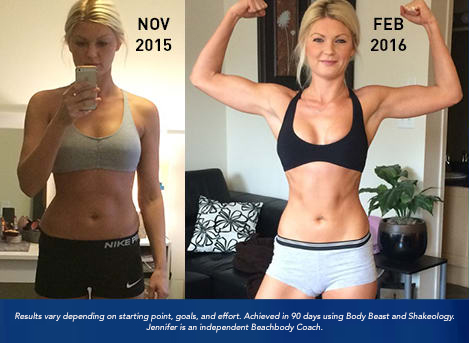Women Who Lift: Why Body Transformation Selfies Are Bulking Up

There’s a new fitness photo trend taking hold of the Internet. No, it’s not the sweaty gym selfie or the self-timed yoga pose pic. It’s a variation of the classic before and after weight-loss photo, with one major difference: the focus is not on losing weight, but rather on gaining strength. These new selfies show people, particularly women, sharing their evolution from slim to strong, thanks to strength training.
Of course, each individual transformation varies significantly, but the selfies share an obvious theme: the before photos feature bodies with little to no muscle definition, while the after photos show bodies with noticeably bigger, more defined muscles.
Jericho McMatthews, BODi Super Trainer and co-creator of CORE DE FORCE, calls the trend refreshing and empowering. “These selfies are reshaping the idea of beauty not only by placing more emphasis on strength and confidence, but [by] embracing individuality—flaws and all.”
Amanda Dale, ACE-certified trainer and sports nutritionist, says she thinks the trend could be a reflection of current pop culture. “Think of Ariana Grande’s latest ‘Side to Side‘ video on exercise bikes, or Khloe Kardashian’s ‘Revenge Body‘ TV show as examples of how pop culture is appropriating the image of health and fitness as a lifestyle trend,” she explains. And there’s definitely no shortage of strong females in the record-breaking “Wonder Woman” movie.
Regardless of whether or not this trend was born from celebrity influence, one thing is clear: these selfies, as well as the body-positive captions that accompany them, are helping to change the cultural norms around body image. As Dale remarks, “If [strength transformation] selfies can help empower women to move past the ‘smaller is better’ message we’ve been receiving since birth, then I’m happy about the trend.”
Weight Loss Isn’t Always the Goal
The path to improved health and fitness is different for everyone. As McMatthews explains, no two healthy or fit bodies look the same. “[Being healthy] is so much more than a clothing size or the number on a scale,” she says.
In fact, many of the strength transformation selfies feature women who haven’t lost weight. Instead, their weight has remained the same or even increased. When you focus on building muscle, you might not notice a drop in the number on the scale, but your clothes might start to fit looser. “Or, you may even gain a little weight, but also notice more shape and definition in your arms, abs, legs, and butt,” McMatthews says.
This is because muscle tissue is denser than fatty tissue, so muscle weighs more than fat by volume, explains Trevor Thieme, C.S.C.S. “That’s why it’s important to pay more attention to the changes you see in the mirror than to the number you see on the scale,” he says. If you really need proof in numbers, you can track your body fat percentage, and watch how it changes as you become stronger.
Strength Training for Women
Have you ever heard (or uttered) the phrase, “But lifting weights will make me look manly!”? This new selfie trend is helping to shatter that myth. “There is absolutely no way that women can get ‘big muscles’ lifting weights in a reasonable strength training program,” Dale explains.
Why? Because it’s just not how women’s bodies are engineered. “Men are genetically predisposed to build more muscle than women,” Thieme explains. “Barring the use of steroids, most women will struggle to ever be able to build as much lean mass as most men.”
Dale adds, “Women who claim they ‘get bigger’ from lifting are often referring to the fact that they [may] appear larger after weight training due to building additional lean mass without losing the fat on top, contributing to a slightly bulkier look.” But the right program will help you shed the excess fat as well, resulting in a more slender physique.
More and more women are realizing this fact and embracing their strength. “Women want to be strong because to be strong is to be powerful, fierce, and indestructible,” McMatthews says.

The Benefits of Strength Training
So how are all these women achieving their incredible strength transformations? It comes down to effective training. “Studies show that women can reap the same benefits from resistance training as men without adding bulk — namely, greater strength, less fat, more power, enhanced energy, improved mobility, and a lower risk of injury (if you’re smart about your training),” Thieme says.
Oh, and it can also burn more fat than steady state cardio, like distance running and cycling. “You might burn more calories while you exercise with running, but strength training burns more total calories, because your metabolism remains elevated for much longer after you stop working out,” says Thieme. That’s because strength training causes more micro-damage to muscle tissue, and repairing that damage requires energy, which your body pulls from fat stores when you’re not exercising.
4 Ways to Increase Strength and Build Muscle
Ready to give this whole strength training thing a try so you can boast your own transformation selfie? Follow these tips to get started.
1. Focus on bodyweight exercises first
If you’re new to strength training, begin with bodyweight exercises, like the squat, lunge, plank, and push-up. “Focusing on bodyweight moves will help you master proper form, which will set you up for greater success once you start adding weight to the equation,” Thieme says.
Dale agrees. “One of the easiest ways to start building basic core and upper body strength is to focus on performing a perfect push-up, something you can practice anywhere, any time, with absolutely no equipment at all,” she says. If you find the classic exercise too difficult, then start with an easier variation to help you become better at the push-up.
2. Try HIIT
High-intensity interval training, better known as HIIT, ramps up your heart rate and challenges your muscles by alternating short bouts of intense effort with brief periods of rest. Think: 30 seconds each of the jump squat, push-up, bridge, dip, reverse chop, and mountain climber with just 10 seconds’ rest between them—and then repeating that circuit five to six times.
It’s the fast-paced, full-throttle nature of HIIT that makes it so effective at not only challenging both muscular strength and endurance, but also burning fat. Indeed, studies show that HIIT burns more total calories than either strength training or steady-state cardio alone. That’s one of the reasons why HIIT is a cornerstone of many BODi programs.
3. Consume protein post-workout
Optimize your recovery and muscular gains by following your strength workouts with a dose of whey protein. “[This helps] speed up muscle repair and recovery,” McMatthews says. Try a post-workout shake like Beachbody Performance Recover. It has 20 grams of protein and 10 grams of carbs to help build muscle and replenish glycogen, as well as pomegranate extract to help reduce exercise-induced soreness. Plus, it comes in two tasty flavors: Chocolate and Orange.
4. Stick to a program
To build muscle mass, you have be consistent with your workouts, which means a once weekly sculpt class probably won’t cut it. Aim for at least two to three strength training sessions a week, and schedule regular rest days to allow your muscles to recover.
“Start with light to moderate weights and aim for two to three sets of 8 to 12 reps per exercise/muscle group,” says McMatthews. “As your strength improves, gradually increase the weights and regularly change up your exercises to work your muscles in different ways.”
A structured workout program (like those mentioned below) will help eliminate a lot of the guesswork and increase your odds of success. Check out BODi to find the perfect one for you.
Strength Training Programs
If you’ve never lifted a dumbbell in your life, start with a program that includes a combination of weighted and non-weighted workouts. 21 Day Fix is a good introduction for people who are beginners to both working out and using weights, and it incorporates both cardio and strength training to help you build muscle and shed fat.
For a more traditional weightlifting program, check out Body Beast. This 90-day body-building program uses dynamic set training (a combination of different weight training strategies), which can help both men and women burn fat and build lean mass. Indeed, there are plenty of women who have gained serious muscle with this program.
Another option is The Master’s Hammer and Chisel. “It’s a comprehensive resistance training program that includes stabilization training, muscular endurance training, muscular hypertrophy, absolute strength, and power,” says Stephanie Saunders, NASM-CPT, BODi’s vice president of fitness programming. Created by trainers Autumn Calabrese of 21 Day fix and Sagi Kalev of Body Beast, it employs both HIIT and traditional strength training to maximize your body-sculpting results.
If you don’t have a lot of time to spare, 22-Minute Hard Corps is for you. “It’s a military-inspired training program that uses bodyweight and resistance training to create strength and increase muscle mass in just 22 minutes a day,” Saunders says. How’s that for time efficiency?
Not only are these programs an easy way to follow a structured strength training plan, they also allow you to do strength training at home or at the gym. So whether you want to try strength training for fat loss or muscle gain (or both!), with a little hard work and dedication, anyone can jump onboard this new transformation selfie trend.
